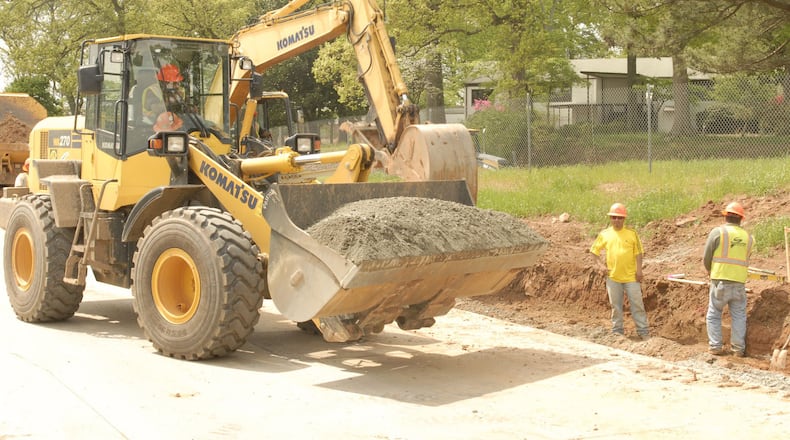Along Moreland Avenue in Forest Park, a few miles east of the Atlanta airport, Kroger and a development team are building a shopping mall-sized distribution center at Fort Gillem, the sprawling former Army logistics post.
Farther south, down I-75 in Henry County, MetLife and a California developer have started the first of several warehouses being built on spec — or without an anchor tenant lined up. Millions of square feet of new industrial or logistics centers are also underway up I-85 northeast of Atlanta and to the west along I-20.
No, warehouses are not the sexiest players in commercial real estate. But they’re where a lot of the action is these days in metro Atlanta, and in some ways they’re a bellwether for the region’s economy.
Overall, more than 16 million square feet worth of warehousing and industrial space — or about the size of 10 large shopping malls — was under construction at the end of March. That’s more than at any time in a decade, according to real estate giant CBRE.
Metro Atlanta’s highways, rail lines and airport, along with its proximity to the port of Savannah, have long made it a distribution hub. Atlanta is the ninth biggest U.S. metro, but it has the fourth-largest amount of industrial space — largely distribution centers, according to CBRE Research.
All the new construction — some for specific companies like Kroger, other projects built on the hopes the new space will draw tenants — is based on demand stimulated by job growth, increased consumer spending and a rebound in domestic manufacturing, industry watchers say.
“We are blessed by geography and we are blessed by infrastructure,” said Chris Carr, the state’s head of economic development. “Domestic companies want a footprint in the Southeast, international companies want a footprint in North America, and generally they want the United States. And when they want the U.S. they generally want the Southeast.”
In metro Atlanta, most of the region’s industrial space is made up of warehousing, though some is devoted to manufacturing. E-commerce companies, retailers, food processors, grocers and others use metro Atlanta as a distribution point for local and regional customers.
Companies filled up — or “absorbed” — about 17.3 million square feet of space last year. Another 4.1 million square feet was gobbled up through the first three months of this year.
“(Demand) has been building for the past three years,” said Todd Barton, a first vice president over industrial properties at CBRE. “The question was: Would it hold into 2015? The answer is definitely yes.”
After the glut
The Great Recession didn’t just savage the housing market, retail centers and office towers; the industrial sector took a bruising, too. Consumer spending evaporated and corporations pulled back on expansion plans, emptying space and leaving new buildings vacant.
Metro Atlanta’s glut of empty distribution and industrial space peaked in 2010 at more than 92 million square feet, or about the size of 45 Perimeter Malls, according to data firm CoStar Group. That figure has been cut nearly in half.
The metro Atlanta vacancy rate now stands at 8.7 percent, down from 15 percent almost five years ago, according to CBRE Research. About three-fifths of the space under development in the first quarter is being built on spec.
On a recent afternoon at Fort Gillem, under the flight path of jets landing at Hartsfield-Jackson, crews were working to enlarge the entrance to the former Army post, which largely closed in 2011. The government retained about 250 acres for a military forensic lab.
A development team and a civilian authority want to convert more than 1,100 acres at the complex into a business park for logistics centers and clean manufacturing. Kroger is the initial tenant, with plans for a $175 million distribution center set to open this year.
Developer Weeks Robinson Properties is working on plans for a next phase of development, a speculative building of about 850,000 square feet on about 50 acres, said Fred Bryant, who is leading the civilian authority charged with redeveloping the post.
“They are very confident it won’t stay empty for long,” Bryant said.
Calls and code names
Bryant said he can tell the activity in metro Atlanta’s industrial and logistics sectors is picking up by the phone calls and parade of code names from brokers and economic development officials.
Forest Park officials hope redevelopment at Fort Gillem can help generate demand for a retail renaissance downtown.
In July, New York-based insurance giant MetLife and its partner, Panattoni Development Co., announced plans to build a 3 million square feet logistics center on spec in Henry County off I-75. The partners are contemplating expanding that project to nearly 5 million square feet.
The companies have a second smaller speculative industrial development planned in Buford, northeast of Atlanta. Each project is awaiting various approvals by regional planners.
Chuck Davis, regional director for MetLife Real Estate Investors, said demand has been fueled by the need for “fulfillment centers,” the places where merchants store and ship goods purchased by consumers on the Internet.
Another area of growth, he said, has been in light manufacturing and in distribution centers that service nearby factories. Auto plants and their suppliers need places to store their goods, for instance, and they want to be close to the main factories and major interstates.
“We think 2015 is going to be a good year and we’re hitting the market just right,” Davis said.
About the Author
Keep Reading
The Latest
Featured



